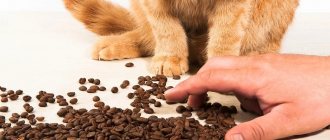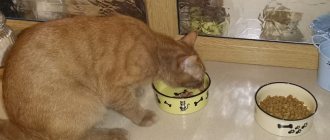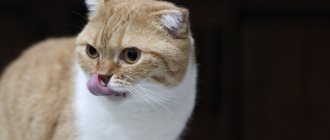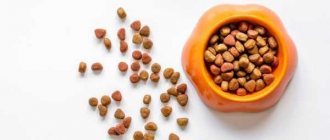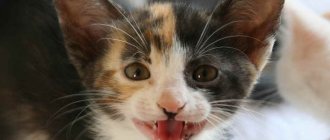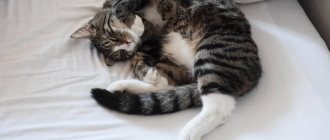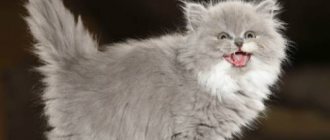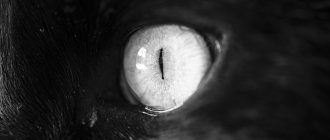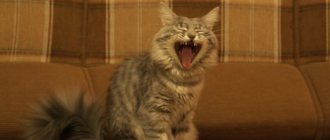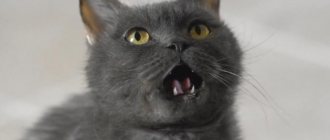When a person adopts not a kitten, but an adult pet, sometimes he is faced with the fact that the cat categorically does not eat dry food. Most often this happens because the cat got used to eating something else while living with the previous owner or on the street. Volunteers at the Murkosha shelter often encountered a similar problem and over time developed a specific strategy that helps transfer the cat to dry food.
1) The benefits of dry food 2) Why an adult cat does not eat dry food 3) Why a kitten does not eat dry food 4) Features of accustoming to dry food
Appetite decreases due to stress
The first thing new owners do is feed their pet. Having brought the kitten home, they pour him a whole bowl of food and expect him to immediately empty it. But at this time the baby is experiencing extreme stress: separation from his mother, moving to a new home, a complete change of environment. No wonder he has no time for food.
Take your time with feeding. Let the kitten explore the territory, come to terms with the separation, and get used to new people. If there are other animals in the house, keep them in another room for now. After an hour or an hour and a half, you can offer dry food: most likely, by this time the new pet will have worked up an appetite and will eat more willingly.
The unusualness of new food
One explanation may be the animal’s banal unaccustomed to dry food. Life experiences shape eating habits and stereotypes, so if a cat has eaten exclusively natural food all its life, it may well not associate dry granules with food.
According to zoologists:
- Wild predators feed on the juicy flesh of their victims, and therefore cats instinctively absorb food with a high moisture content.
- Butchering whole prey whets the appetite, forcing you to separate portions and chew them thoroughly.
- The first feeding of small kittens should be especially rich in liquid to ensure optimal functioning of the delicate digestive system, which previously could only cope with milk.
Seductive wet food. If the animal looks good on homemade food and does not complain about appetite or health, then it would be more logical to leave the diet the same. But if the owner has firmly decided to feed the pet with industrial diets, then canned pates and pieces of meat in gravy can be offered as a transition link between natural food and dry food.
Typically, cats happily consume the contents of jars and bags, the ingredients of which, within the same brand, are not much different from dry food (except for the percentage of water). Perhaps, having tried wet food, the cat will deign to try dry granules.
Just for young animals and overly picky cats, manufacturers recommend mixed feeding, consisting of a portion of dry food and 1-2 bags of juicy food.
Taking into account the peculiarities of the recipe, it is advisable to choose granules and canned food of the same brand.
Gradual change of tastes. An option for “drying” training is to mix dry food granules with the usual food, which the cat eats with pleasure. It could be:
- chopped meat;
- sour cream;
- kefir;
- curdled milk;
- milk;
- bouillon.
After mixing, you need to wait a while for the granules to swell a little and become saturated with liquid.
Introduction of the first complementary foods. As the first complementary food for kittens aged 3-4 weeks, special dry food granules are soaked in warm boiled water until pureed (read more about how to properly soak dry food for kittens). If the baby refuses to eat, then you should gently open his mouth and smear a small amount of puree on the roof of his mouth. The procedure is repeated until the kittens begin to independently take food from their fingers, and then from the bowl. By 2 months, the amount of fluid is gradually reduced so that the growing baby learns to use his teeth and is not lazy to chew.
Selection of dry food. Sometimes cats have a strange taste and stubbornly refuse to eat the popular and beloved food or the one that is intended for them by age and breed. In such a situation, the owner has no choice but to offer the furry gourmet to choose by purchasing 5-10 types of dry food in small quantities at the pet store.
The main thing is not to forget to make a note about the corresponding brand and product name. Having sniffed the food offered in different bowls, the cat will still deign to eat this or that food, making it clear that he prefers fish, liver or an abundance of vegetables.
"Composition". Many owners ask the pet store seller to build a kind of “collection” of dry food of different flavors and brands in one bag, anticipating the pickiness of the pet. This is also done in order to save money, so that the granules of expensive food are mixed with cheap pieces.
Veterinarians do not advise constantly changing the manufacturer, or even more so feeding homemade mixtures of dry food, since the intestinal microflora adapts to the usual type of food.
Possible reactions to unfamiliar food may include vomiting, upset, or allergic reactions.
No habit of dry food
If your kitten has never tried dry food before, he will probably be suspicious of such food. Wet food from bags and natural food smell more intensely in comparison with dry granules, which predetermines the pet's preferences. Soaking with warm water can be a way out. This way the granules acquire a more pronounced meat aroma and a consistency familiar to the baby.
If this does not help, you can initially mix dry food with wet food, increasing the proportion of the former every day. Normally, such a transition takes 5–10 days. During the soaking and mixing period, the kitten will have to be fed frequently (5-6 times a day), offering a fresh portion each time. As soon as he begins to consume dry food, you can pour granules twice a day - morning and evening. The baby will come to the feeder when he is hungry, even if he is left alone at home.
Reasons for refusing food
If your cat does not eat dry food, then the main thing is not to panic and identify the reason for this behavior. It is worth considering that a pet can simply take a small amount of food per day, because food swells in the stomach and very little is needed to saturate it. In hot weather or during heat, the animal should limit itself to a few grains.
The reasons can be harmless or dangerous. The main ones:
- The same food that your pet is tired of. Many owners believe that dry food will be enough to feed the animal. But his menu should consist of more than just one dish. A balanced diet will give your pet the necessary amount of vitamins and nutrients that are needed for the healthy development of the animal’s body. In order for your pet to absorb a sufficient amount of vitamins, it is worth adding soups, canned food, fish, meat, cereals, etc.
- Lack of appetite. This phenomenon occurs during the hot season. During this period, the animal behaves lazily and is not very hungry. Therefore, your pet should be fed twice a day: morning and evening, constantly changing the water.
- Improper storage. It happens that the owners do not follow the rules for storing the product and it becomes damp and loses its taste. To avoid this problem, you need to buy small packages that have a longer shelf life.
- Poor quality product. The kitten will not like the selected food because it does not suit its taste preferences. It can be either cheap or expensive. Therefore, before buying food, you need to study your pet's taste preferences.
- Dirty dishes. Representatives of the cat family are extremely clean, so their dishes must be perfectly clean.
- Appearance of the dishes. The design and shape of the bowl affects the feeding of the cat. When choosing dishes, you should give preference to neutral colors that will not scare away your pet. Therefore, you should choose ceramic and metal bowls.
- Pet stress. Loss of appetite in cats is also associated with stress. It occurs due to moving away from home, noisy company, the birth of a child, visiting a veterinarian, etc. The appetite will return within a week.
- The animal prefers natural food.
https://youtube.com/watch?v=isQFkoADTS4
These are not all the factors that can discourage a pet from taking dry food. There are many reasons, and the worst are diseases.
Diseases and poor health
If an animal stops eating not only dry food, but also regular food, then the reason for this is the onset of a painful process. It can be:
- poisoning;
- diseases of the gastrointestinal tract;
- problems with teeth or gums;
- kidney and urinary tract diseases;
- pathologies;
- parasites.
Bad food
When an animal does not eat dry food well, sometimes the reason lies in the quality of the product itself. Perhaps it is not tasty enough or spoiled. Cats are obligate carnivores and are most attracted to meat, so it is important to choose food with a high content of it. Acana and Orijen diets consist of 75–85% meat ingredients and other animal products (fish, eggs, innards). This is an excellent choice both for raising kittens and for maintaining the body of an adult cat.
Don't forget that even the highest quality food can be spoiled if it is expired or stored incorrectly. Cats, like other animals, have an innate ability to distinguish healthy and safe food from harmful and inedible food. If the fats in the food have oxidized, a person may not feel it, but the kitten will not eat such food, and rightly so. The owner will have to purchase fresh packaging of food and store it properly in the future.
The one who always ate does not eat
It is not surprising if a cat refuses to eat dry food, which he always ate with pleasure. This happens often, but it does not mean that something happened to the animal. Perhaps I'm just tired of the smell and taste. It's time to find a worthy replacement for your usual food. You don’t have to look for an analogue; you can try a completely different type of nutrition. Let’s say if you constantly used dry food “Friscas with vegetables”, then what’s stopping you from offering a piece of liver or chicken fillet? It is possible that the cat will be delighted with such a treat.
The same applies to kittens. You need to try everything, but do not overfeed with different foods. This is necessary in order to understand what the animal’s preferences are: natural food or food industry products.
Food vagaries
Little kittens evoke affection and a desire to care. Everyone around is trying to treat them with something tasty, without thinking about the consequences. In fact, such “care” backfires on both the owners and the animal:
- the baby develops the habit of begging;
- food whims arise: the kitten does not eat dry food well, because it hopes for something “yummy”;
- nutrition is not balanced, which negatively affects the development of a growing body.
During the period of accustoming to dry food, it is recommended to exclude all treats and treats. Warn all family members about this so that they do not inadvertently violate your plan.
Why doesn't an adult cat eat dry food?
There are several main reasons for refusing dry food:
1. Habit. If a cat lives with a person, it gets used to the latter’s lifestyle and diet. Such habits are difficult to eradicate because they begin to work at the level of reflexes.
2. Wrong smell. Often, cats don't like a certain type of food simply because it doesn't smell like natural food. If, for example, a cat is accustomed to catching mice or eating meat from the owner’s table, then after sniffing the food, she will understand that it is a completely different product and will begin to refuse.
3. Consistency and temperature. These two parameters are very important for a cat. And if he doesn’t like the food to be cold or too large, the cat will refuse to eat it.
Health problems
Sometimes owners' concerns about their pet's poor appetite are justified. We are talking about illnesses and problems with well-being. If a kitten that is already accustomed to dry food suddenly begins to eat poorly, you should be wary. Other symptoms may be observed: fever, lethargy, apathy, diarrhea or vomiting. Then you need to contact your veterinarian and follow his recommendations.
Situations are especially alarming when the animal does not drink and loses interest not only in dry food, but in general in any food, including its favorite treats.
Determining the causes
Start by studying the composition of the food your pet refused. Read reviews about this manufacturer. Pay attention to whether there are cases of allergic reactions, whether problems with the gastrointestinal tract of animals have been recorded.
If the manufacturer is popular among cat owners, then analyze the shelf life of the product and its storage conditions. Quite often, whimsical kittens refuse the product because it is not fresh. Food that has not been stored properly can absorb foreign odors that can overpower your favorite flavors.
Keep an eye on the cups where the food is placed. Cats and cats are clean animals. Leftovers from previous meals can completely kill your appetite. And the absence of a cup of clean water next to a cup filled with food can turn the pet around for the purpose of self-preservation. Drinking is important for health, don't forget about it.
If the baby is very small, then refusing to eat may mean a simple inability to cope independently without the help of a cat. Lack of experience in eating, no matter dry or wet food, can lead to constant refusals. Then the pet should be helped and taught to eat on its own.
In fact, the kitten eats not so bad
Often, owners only think that the animal is not eating enough. In reality, the whole point is that the baby’s needs are small. Calculate the daily feeding amount for your pet and see if he eats it. For Acana and Orijen feeds, the daily dosages are as follows:
- 60 grams per 1 kg of weight when the kitten has not yet reached the age of 20 weeks;
- 30 grams per 1 kg of weight - after 20 weeks (during this period, kittens no longer grow so intensively).
Upon reaching 12 months, the cat is considered an adult and should eat in accordance with the general norm.
Listening to the animal's opinion
It is very important to observe how the animal reacts to different types of food. If the kitten does not want to eat dry food, then natural food is preferable to him: dairy and meat products that you yourself eat.
The body of an animal, especially a kitten, is very sensitive. As long as it is not contaminated with various harmful additives, it is able to determine which foods are good for it and which will harm it. Therefore, you should not punish a kitten for its reluctance to consume something that, in its opinion, is harmful.
What to do
From the very first days of a kitten’s stay in the house, you need to decide what will be more convenient to feed it. If the choice falls on dry food, you need to accustom it to it from an early age. When exactly, you should consult a veterinarian.
If it is not possible to give your pet good premium and super-premium food, then it is better to feed your pet natural food:
- What is the difference between the feeds? Warnings regarding inexpensive feeds have good reason. They consist mainly of cereals, meat, and there are practically no high-quality offal in them. A caring owner will not feed such food to a small kitten, risking its health and even life. Economy class food should only be used as a last resort.
- The premium food group is more suitable for the diet of small kittens. Many manufacturers producing this product also include kitten food in their series. The food already contains more meat and less grains.
- The best option is super-premium ready-made food . Its components are only natural, there are no flavors or dyes.
If you can't spend a lot of money on super premium, you need to find a good premium brand. It is important to combine dry food with canned food. How to properly feed a kitten from the first months of its life can be found out from the veterinarian who is observing the pet.
Manufacturers indicate on the packaging the recommended serving for kittens of a given age; you should definitely follow these recommendations. If overfed, the kitten will quickly recover, but obesity can lead to serious illnesses.
Dry food is usually introduced into the diet at six weeks of age. But it’s better to wait until six months or a year. The period of getting used to such food will take some time, you need to be consistent and not rush. Dry food becomes complementary food, a supplement to milk. The addiction should become gradual.
IMPORTANT! You cannot suddenly change the nutritional system of not only a small kitten, but also an adult.
If a cat owner treats this issue irresponsibly, this can lead to big problems for the animal’s health. At best - diarrhea, vomiting, constipation. The digestive system can be seriously damaged and treatment will be necessary.
When purchasing a kitten from a breeder, owners usually receive a pet that is already accustomed to a certain type of food. You should find out the brand in order to give the animal the same food, at least for the first time.
Options for how to wean a cat from burying a bowl of food
There are many options for weaning an animal from burying. You should understand the possible reasons for this behavior, and then follow the basic tips:
- give food often, but in smaller portions; you need to monitor what and how much your pet eats;
- you can distract your pet with a game if the owner sees that he is starting to hide his treat;
- You should not leave the bowl when the animal has eaten. It is better to remove the cup, clean the floor and simply refresh the cup of water;
- It is important to regularly wash and scrub the bowl itself to remove any residue;
- you need to check whether the cat likes the selected brand of food;
- Do not place the eating area near the pet’s toilet.
To wean an animal from a bad habit, you need to understand the reasons
Improve your cat's nutrition
Cats are very picky about what they eat. To wean the habit of burying food, you should adjust your diet. Basic tips:
- choose one good and high-quality brand of cat food manufacturer and stick to it in the future;
- organize meals several times a day at set times in small doses so that there is no waste left;
- reheat if necessary to increase appetite;
- you can pour chicken broth over the food to make it more attractive to your pet;
- It doesn't hurt to add a small amount of strong-smelling cheese to pique your pet's interest.
For your information! If all else fails, you should switch to wet food. Sudden changes in diet without warning can cause stomach upset.
Washing the bowl
Washing the bowl is an important part of keeping your pet's dining area clean. Cats are very picky about the order around them, especially when eating.
A dirty bowl with leftovers from your last meal can be a source of disgust. The cat recognizes such food as garbage, which it will not eat. In an attempt to get rid of garbage, the animal will bury the bowl.
Important! You should not wash the bowl with strong-smelling chemicals (household products), which can also discourage your pet from eating food. It is better to use regular laundry soap for these purposes.
It is preferable to use stainless steel utensils, since food debris can be easily removed from its walls. Plastic utensils absorb odors, and scratched surfaces can trap food residue.
Washing the bowl is the key to keeping your cat clean.
Comfortable place to eat
If your pet doesn't like the place where the food bowl is located, this fact will cause him discomfort when eating. The animal does not feel safe. The factor that is negative should be identified and eliminated. This may be: foreign or unpleasant odor, uncomfortable temperature. You should also make adjustments to the environment, for example, changing the location of the bowl.
Finally, why do pets bury their food? This is a survival instinct. Wild animals hunt and kill prey, eat food and hide the leftovers. According to the pet, food served in a bowl is no different from the fresh version. If he is not hungry enough to finish his meal, he will hide the evidence and hide it. Hiding food is a common cat behavior and is usually harmless. If the owner is interested in weaning his pet from such a habit, then it is enough to use the advice from this article.
